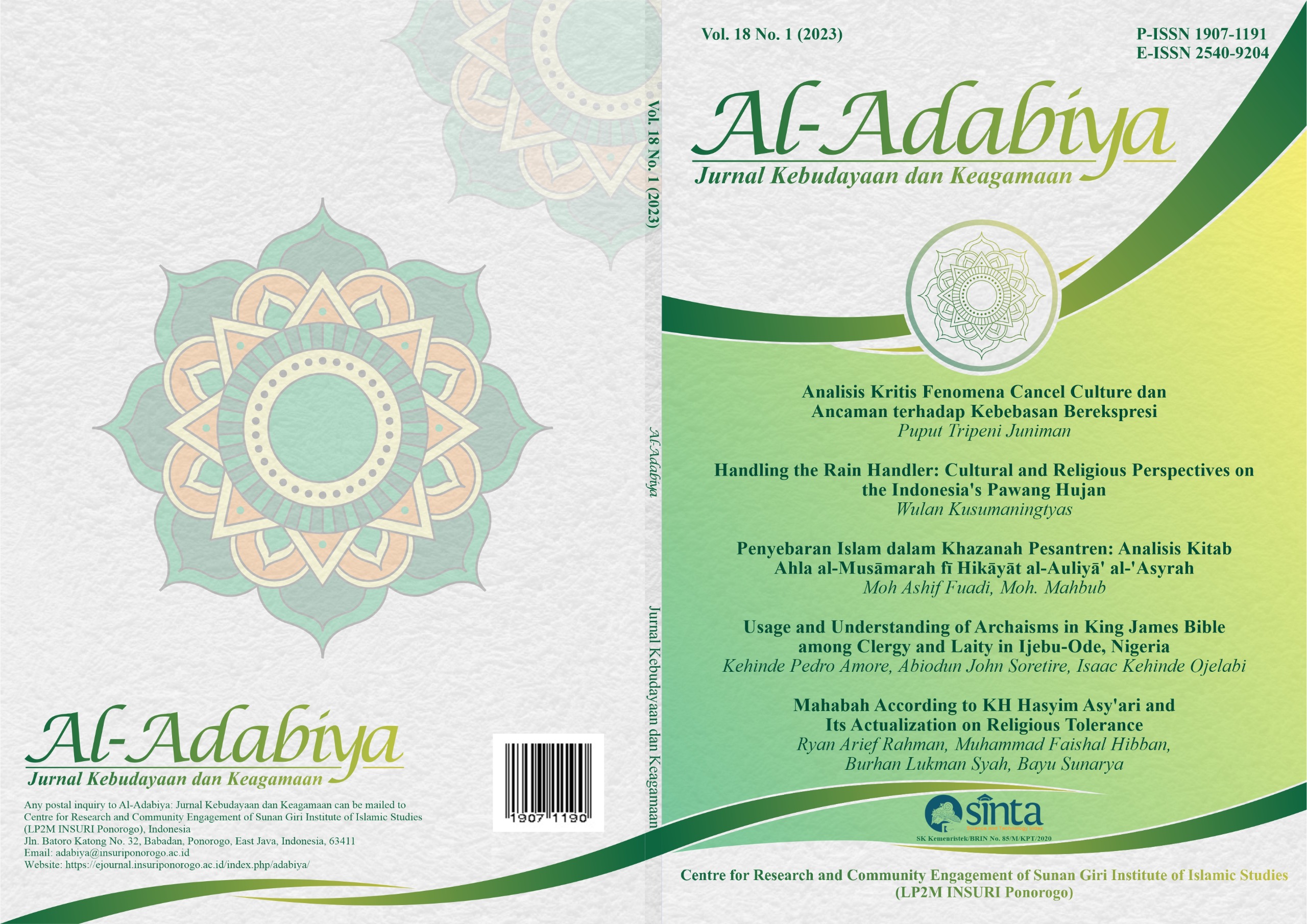Usage and Understanding of Archaisms in King James Bible among Clergy and Laity in Ijebu-Ode, Nigeria
DOI:
https://doi.org/10.37680/adabiya.v18i1.2922Keywords:
Archaisms, Clergy and Laity, King James Bible, personal pronoun, verb-endingAbstract
This study was a survey of usage and understanding of archaisms of personal pronouns and verb endings in the King James Bible among the clergy and laity of selected churches within Ijebu-Ode metropolis of Ogun State, Nigeria. The study adopted the survey method with a sample size of 40 respondents selected via simple random sampling technique and 10 recorded homilies/liturgies from the selected churches cutting across the two major denominational blocs (Pentecostal and Protestant) using the King James Bible within Ijebu-Ode metropolis. Questionnaire was the main instrument used to obtain relevant information from the respondents who cut across various demographic groupings. Transcription served as the supporting instrument to gather pertinent data from the recorded homilies/liturgies. Thereafter, the descriptive method was employed in analysing the data gathered. The findings of the study enunciated the fact that archaisms of the King James Bible are still being used in churches through different platforms but majority of congregants lacked the proper understanding of the lexico-semantic and grammatical values of these archaisms. It is then recommended that clergymen should engage in thorough investigation into the KJV archaisms and the advantages they offer and educate their people accordingly, among other recommendations.
References
Abbot, E. A. (2013). A Shakespearian Grammar: An Attempt to Illustrate Some of the Differences Between Elizabethan and Modern English (Kindle Edition). Dover Publications.
Aitchison, J. (1992). Language Change: Progress or Decay? Cambridge University Press.
Aliyeva, Z. (2022). Lexical means of historical stylization: archaisms and historicisms. Journal of Modern Educational Achievements, 3, 150-154.
Aliyeva, Z. R. (2022). The concept of historical styling. Galaxy International Interdisciplinary Research Journal, 10(11), 768-784.
Amore, K. P. (2018). Introductory English Morphology. Nigeria, Charis, and Saris Publisher.
Amore, K.P. (2015). Essential Aspects of English Grammar and Usage. Nigeria, Charis, and Saris Publisher.
Barber, C. L. (1997). Early Modern English (2nd Ed.). Edinburgh University Press. 24.
Barmash, P. (2017). Symposium: Does Archaic Biblical Hebrew Exist? Pamela Barmash. Hebrew Studies, 58(1), 47-47.
Berg, T. (2020). Authorised: The Use And Misuse of The King James Bible”—A Review. King James Bible History. https://kjbhistory.com/authorized-the-use-and-misuse-of-the-king-james-bible/
Bowen, G. A. (2016). Sounding Sacred: The Adoption of Biblical Archaisms in The Book of Mormon And Other 19th Century Texts. https://docs.lib.purdue.edu/open_access_dissertations/945
Brinton, L. J. (2000). The Structure of Modern English: A linguistic Introduction. John Benjamins.
Canon, E. B. (2016). Buried Treasure in the Tyndale Corpus: Innovations and Archaisms. ANGLICA-An International Journal of English Studies, 25(2), 151-165.
Chomsky, N. (2002). Syntactical Structures. Mouton & Co.,‘s-Gravenhage.
Compton’s Encyclopedia (Vol. 7). (1985). F.E. Compton Company.
Cook, E. M. (2018). On some supposed archaisms in Mishnaic Hebrew. Maarav, 22(1-2), 11-20.
Costin-Gabriel, C., & Rebedea, T. E. (2014). Archaisms and neologisms identification in texts. In 2014 RoEduNet Conference 13th Edition: Networking in Education and Research Joint Event RENAM 8th Conference (pp. 1-6). IEEE.
Der Manuelian, P. (2022). Living in the past: Studies in archaism of the Egyptian Twenty-sixth Dynasty. Routledge.
Dixon, R. M. W. (2009). Basic Linguistic Theory (Vol. 1). Oxford University Press.
Ellis, S. (2011, Juli 1). The King James Bible: Still The Word After 400 Years. British Heritage Travel.
Fennell, B. A. (2001). A History of English: A Sociolinguistic Approach. Blackwell Publishing.
Gasparyan, S. (2023). Some linguistic and stylistic properties of the King James Bible. Folia Linguistica et Litteraria 44(2023), 9-21.
Gasparyan, S. (2020). The Historical Background of The King James Bible. Armenian Folia Anglistika, 16(2).
Girsang, M., Nababan, D. E. O., Barus, K. G., Panjaitan, M. M., & Hutasoit, S. M. (2023). Archaic word usage in English literary works. Media Bina Ilmiah, 17(7), 1745-1756.
Greteman, B. (2013). Archaic Style in English Literature, 1590-1674. Philological Quarterly, 92(3), 437-442.
Harbach, R. C. (2022). Biblical Archaisms. https://cprc.co.uk/pamphlets2/archaisms/
Hedvall, E. (2008, April 28). Thou, Thee, Thy, Thine, Ye, You, Your, Yours: Second Person Pronouns In Two Bible translations. http://www.uppsatser.se/uppsats/76f4242ff9/
Hu, J. & Lu, H. (2017). The application and E-C translation methods of common archaisms in business contract. Theory and Practice in Language Studies, 7(9), 798-803.
Jabbari, M. (2023). The Poetics of Archaism: Victorian Translators of Old Norse and Persian Legends. (Doctoral dissertation, University of Michigan).
Jeffcoat, B. A. (2016). English Bible History. English Bible History. www.greatsite.com/timeline-english-bible-history/index.html, 2013
Kashima, K. (2017). The aeneid and archaism. Harvard: Persephone: The Harvard Undergraduate Classics Journal, 2(1), 5-18.
Kortmann, B. A. (2004). Handbook of Varieties of English: CD-ROM. Mouton de Gruyter.
Kperogi, F.A. (2014). 12 most popular archaisms in Nigerian English. https://www.farooqkperogi.com/2014/03/12-most-popular-archaisms-in-nigerian.html
Kuiper, K. (2023). King James Version. Dalam Encyclopedia Britannica. https://www.britannica.com/art/Jacobean-age
McGrath, A. E. (2011). The King James Bible and Late Tudor Translation Theories [ABC Religion and Ethics]. The King James Bible and Late Tudor Translation Theories.
Mohamed, E. A. (2021). Semantic Problems of The Usage of Archaic Morphological Features: Surat Al-Humza (Traducer) As A Model. International Journal of Linguistics, Literature and Translation (IJLLT), 4(2).
Munro, L. (2013). Archaic Style In Religious Writing: Immutability, Controversy, Prophecy. Cambridge University Press.
Nordquist, R. (2020). Archaism (words and syntax). Thoughtco. https://www.thoughtco.com/archaism-words-and-syntax-1689130
Phillips, H. (2014). Whither Archaism? The Cambridge Quarterly, 43(3), 277–282.
Quvondiq, M. V. (2022). The Problem of Classification of Archaisms. EPRA International Journal of Research and Development, 7(6), 181–183. 21.
Rather, S. (2014). Archaism, Modernism, and the Art of Paul Manship. University of Texas Press
Schmid, M. T. (2016). Translating the Bible Literally: The History and Translation Methods of the King James Version, the New American Standard Bible and the English Standard Version. Westbow Press.
Suchard, B. D. (2022). Historical (in) accuracy and linguistic archaism in Daniel 5. Biblica, 103(2), 213-226.
The committee on Bible translation. (1978). Preface to New International Version. 10.
Tursunoy, M., & Zarina, S. (2023). Figurative and expressive means of archaic and obsolete words in language. Innovations in Technology and Science Education, 2(6), 140-144.
Umudova, M.T. (2022). Types of obsolete words (archaisms and historicisms). International Journal of Social Science and Human Research 05(12), 5897-5900.
Ward, M. (2020). Review: Laurence M. Vance’s Archaic Words and The Authorised Version. https://byfaithweunderstand.com/2020/06/23/kjvg01/
White, J. R. (1995). The King James Only Controversy: Can You Rust The Modern Translations? Minneapolis. Bethany House Publishers.
Wilcox, H. (2015). The King James Bible in its cultural moment. In The Oxford Handbook of the Bible in Early Modern England, c. 1530-1700 (p. 455). OUP Oxford.
Downloads
Published
How to Cite
Issue
Section
License
The author(s) retain/s the copyright and grant/s Al-Adabiya: Jurnal Kebudayaan dan Keagamaan the first publication rights licensed under the Creative Commons Attribution-ShareAlike 4.0 International License (CC BY-SA 4.0) which allows others to access (search, read, download and quote), share (copy and redistribute the material in any media or format) and adapt (mix, modify and develop) works for legitimate purposes, even commercially, with recognition of the authorship of the work and its initial publication in this journal.







